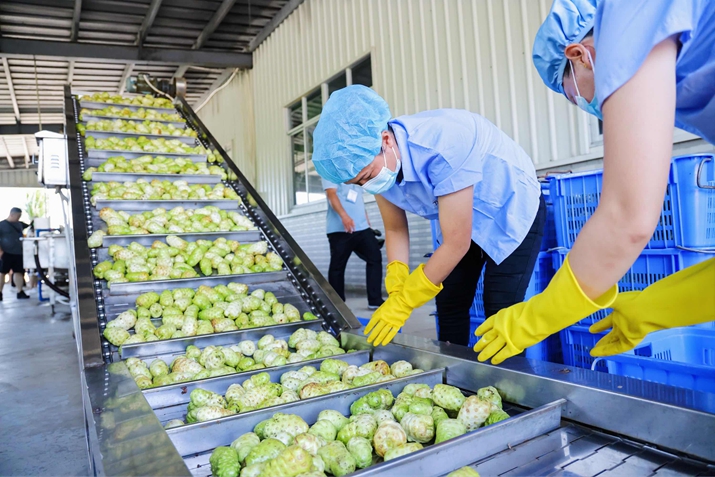| China |
| Hainan Free Trade Port on fast track of development | |
|
|
 Visitors at an exhibition center in the Boao Lecheng International Medical Tourism Pilot Zone in Qionghai, Hainan Province, on July 17 (COURTESY PHOTO)
The construction of the Songtao Reservoir in Danzhou, a city on the tropical island province of Hainan, started in June 1958. Those working on the project calculated that they would need to build a dam 170 meters high in order to protect areas downstream from annual floods. However, lacking heavy equipment and materials such as concrete, the team had to complete the arduous task by hand from successive layers of rammed earth. The passion and dedication of the workers saw them finally reach the required height more than a year later in August 1959. Today, the 3.3-billion-cubic-meter reservoir is the largest body of fresh water in Hainan and serves as the primary source of drinking and irrigation water for its northern and northwestern areas. More importantly, the hardworking spirit embodied by the project, has become an important legacy for Hainan. With the development of a free trade port (FTP) across the island in full swing, it is still inspiring the local people. During the launch ceremony of a seven-day media tour of Hainan on July 16, Chen Jiafen, Executive Vice President of Hinews, a news portal in Hainan, told reporters that since the release of the master plan for the Hainan FTP on June 1, 2020, the island has made achievements in multiple areas, including bringing in talented people and improving the business environment. Greater openness Hainan aims to become a globally influential FTP by the middle of the century. "The policies the Central Government has put in place in Hainan are unprecedented," Zhang Jianping, Director General of the Beijing-based China Center for Regional Economic Cooperation, told Beijing Review. The master plan designates a number of encouraged industries, which will benefit from preferential policies and other supporting measures. One of them stipulates that enterprises from encouraged industries that are either incorporated in or operating in the FTP enjoy a corporate income tax rate of 15 percent. Currently, China imposes a 25-percent general corporate tax rate with exemptions for a few industries such as semiconductors. Similarly, individual income tax for prominent or urgently needed professionals working in the FTP is also capped at 15 percent, compared with the national ceiling of 45 percent. "These two policies are helping attract both domestic and international investors," Zhang said. According to Hainan Daily, 750 major projects with a total investment of 244.4 billion yuan ($38.2 billion) have been launched in the Hainan FTP since last July. Over 375,000 new market entities were established in the same period, up 44.33 percent from a year earlier. Local authorities announced on June 20 that in the first half of the year, paid-in investment in Hainan reached approximately $950 million, an increase of 623.6 percent year on year. The master plan also encourages industrial enterprises in the FTP to produce goods that do not contain imported materials, or that add at least 30 percent in value when processing imported materials. These goods are exempt from import tariffs when entering the rest of China. This policy has attracted many processing enterprises to the China Hainan FTP (Wanling) International Agricultural Products Processing Industrial Park, which is currently under construction in Qiongzhong Li and Miao Autonomous County. Last year, its revenue reached 100 million yuan ($15.45 million). "The first step is always the hardest and we have made it," Ouyang Hua, Deputy Mayor of Qiongzhong, told Beijing Review. The city of Qionghai in east Hainan is home to the Boao Hope City, also known as Boao Lecheng International Medical Tourism Pilot Zone. One part of the zone's appeal is that it allows local medical service providers to fast-track the use of innovative drugs and devices as long as they have been approved overseas. Generally, the process of introducing new foreign-made drugs and devices to the Chinese market takes between three and five years. Yan Lukai, an official with Boao Hope City, said the policy would not only give seriously ill people the hope to live on, but also encourage international pharmaceutical companies to bring the world's most advanced clinical innovations to the Chinese market. By the end of 2020, over 130 medicines and medical instruments had been applied within the zone. Several international companies including GE Healthcare, Boston Scientific and Johnson & Johnson are exploring opportunities in the zone. The zone's administration is creating its own specialized medical insurance policy that will cover the foreign drugs and devices it offers. By the end of May, more than 1.7 million people in China had already purchased the insurance.  Workers process noni fruits at a workshop of Wanwei, a biopharmaceutical company, in Wanning, Hainan Province, on July 17 (COURTESY PHOTO)
Key industries According to official statistics, the volume of Hainan's trade in services grew 81.2 percent to 13.7 billion yuan ($2.11 billion) in the first half of the year. The service sector accounted for 61.5 percent of the local economy in the six months, up from 58.6 percent in the same period last year, and it contributed 79.5 percent to the GDP growth. "Hainan's current industrial structure is good for the development of the FTP," Zhang said. According to Zhang, Singapore's service sector accounts for 70 percent of its economy and the other 30 percent is made up by hi-tech industries, such as electronics and pharmaceuticals. In Hong Kong and Macao special administrative regions of China, services account for over 95 percent of each economy. "Hainan should focus on services and manufacturing with high value added," Zhang said, giving the examples of international trade and logistics, education and tourism. As the master plan proposes to build Hainan into an international tourism and consumption destination, offshore duty-free shopping has become one of the core competitive features of Hainan's tourism. Last July, Hainan's annual duty-free shopping quota was raised from 30,000 yuan ($4,650) to 100,000 yuan ($15,500) per person. In addition, the categories of duty-free goods have been expanded from 38 to 45, with the addition of electronic products such as mobile phones and laptops. The new policy led to an exceptional increase in the sector's business volume in the following 12 months to 46.8 billion yuan ($7.2 billion), a 226-percent surge year on year. On top of the three pillars of the tourism, service and hi-tech industries, the tropical climate on the island has led authorities to specify two additional core industries of agriculture and manufacturing. Fu Wenying, CEO of Wanwei, a biopharmaceutical company in the city of Wanning, introduced noni (Morinda citrifolia), a fruit said to have a number of health benefits, to Hainan in 2004. As Hainan's climate is well suited to commercial production of the fruit, Fu made the decision to establish noni orchards and open juice processing facilities to increase profitability. Fu told Beijing Review that Wanning's noni industry is worth 80 million yuan ($12.4 million). "Our business activities are aligned with the goals of the master plan, I believe we could receive support under the FTP initiative," she said.  Dancers from the Li ethnic group perform at a cultural park in Wuzhishan, Hainan Province, on July 19 (COURTESY PHOTO)
Now or never The establishment of the FTP allows goods to be freely imported and exported between overseas regions and Hainan; meanwhile goods entering other parts of China from Hainan are subject to import regulations, customs duties and taxes, the master plan said. Hainan being an island provides advantages in the administration of this system without the need for building a physical border. It may also help in the prevention of smuggling, cross-border financial crime, and other risks, Zhang said. Last November, China signed the Regional Comprehensive Economic Partnership pact with the 10 members of the Association of Southeast Asian Nations (ASEAN), Japan, the Republic of Korea, Australia and New Zealand after eight years of negotiations. Once in effect, the deal will eliminate tariffs on as much as 90 percent of goods traded between its signatories over the next 20 years. Hainan is located at the geographical center of the upcoming world's largest free trade bloc. Moreover, Hainan is also close to Southeast Asia, making it a connection point between China, ASEAN countries and the rest of the world. Currently, China and ASEAN are the largest trading partner of each other. In the first half of 2021, bilateral import and export volume climbed 27.8 percent to 2.66 trillion yuan ($410.7 billion), according to the General Administration of Customs of China. "The two regional organizations will both provide opportunities for Hainan," Zhang said. "Moreover, China's Hainan, Hong Kong and Macao, as well as Singapore, can constitute a free trade port cluster in the Asia-Pacific region, facilitating regional and global investment and financial cooperation." Hainan officials told a press conference in Beijing on June 21 that they are putting a range of measures in place to ensure thorough implementation of the Hainan FTP Law and to build a sound business environment. Hainan Governor Feng Fei said the government will take a hard line on unsavory business practices such as illegal fundraising. He also pledged efforts to forestall financial risks and to maintain the stability of the real estate market. "An effective legal system is essential to the success of the Hainan FTP," Zhang said, adding that supported by preferential policies, Hainan can explore new opportunities in the development of the FTP. (Print Edition Title: SET SAIL HAINAN!) Copyedited by G.P. Wilson Comments to taoxing@bjreview.com |
|
||||||||||||||||||||||||||||
|